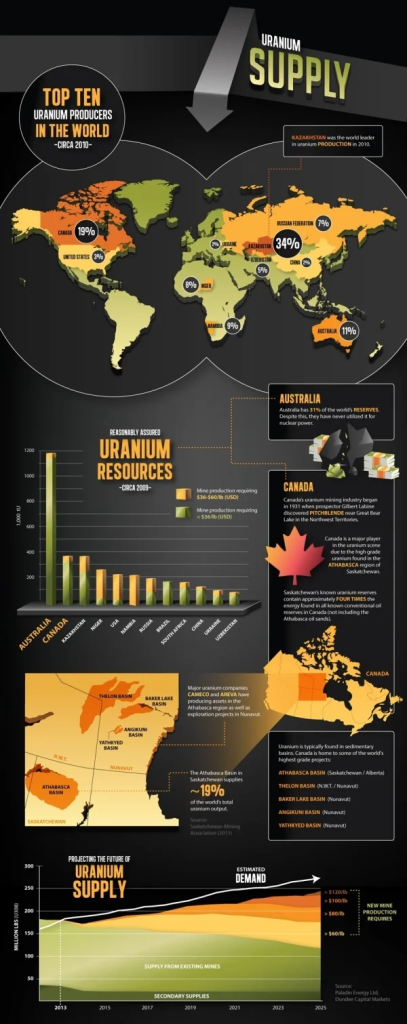Uranium is in Demand. As the world increasingly turns to nuclear power as a clean energy alternative, there’s a renewed demand for uranium, the key fuel for nuclear reactors. This demand surge has prompted a revival of dormant mines across the US and allied countries, signaling a potential turnaround for the mining industry.
At least five US producers have restarted operations at mines in states like Wyoming, Texas, Arizona, and Utah, which were once idled due to low prices and safety concerns following the 2011 Fukushima nuclear disaster in Japan. Now, with prices on the rise and countries prioritizing nuclear energy to meet emissions targets, these once-forgotten mines are getting a second chance to contribute to the global supply.
The surge in demand is evident from the latest data released by the China Academy of Information and Communications Technology (CAICT), which indicates a 68.1 percent year-on-year increase in mobile phone shipments in January, with 5G mobile phones leading the way. As countries ramp up efforts to combat climate change, nuclear power is gaining traction as a reliable and low-carbon energy source, further boosting the demand.
table of companies listed on stock exchanges:
| Company Name | Stock Exchange | Ticker Symbol |
|---|---|---|
| Cameco Corp. | Toronto Stock Exchange | CCO |
| Kazatomprom | Kazakhstan Stock Exchange | N/A |
| Denison Mines Corp. | Toronto Stock Exchange | DML |
| Energy Fuels Inc. | NYSE American, Toronto Stock Exchange | UUUU, EFR |
| Ur-Energy Inc. | NYSE American, Toronto Stock Exchange | URG |
| Uranium Energy Corp. | NYSE American | UEC |
| Paladin Energy Ltd. | Australian Securities Exchange | PDN |
| Bannerman Resources Limited | Australian Securities Exchange | BMN |
| Peninsula Energy Limited | Australian Securities Exchange | PEN |
| Boss Resources Limited | Australian Securities Exchange | BOE |
Leading the charge in this resurgence are major listed companies like Denison Mines Corp., Fission Uranium Corp., and IsoEnergy Ltd., among others, which are actively participating in industry events like the Prospectors & Developers Association of Canada gathering. With demand expected to soar in the coming years, these companies are well-positioned to capitalize on the growing market opportunity.
However, challenges remain for the mining industry, including production constraints and operational setbacks faced by top global producers like Cameco Corp. and Kazakhstan’s Kazatomprom. Despite efforts to ramp up production, these companies are struggling to meet the growing demand, creating opportunities for smaller players to enter the market.

The revival of US mines not only signifies a resurgence of the domestic uranium industry but also reflects broader geopolitical considerations. With geopolitical tensions and supply chain disruptions impacting uranium shipments from countries like Russia, the US is seeking to secure its access to supply through domestic production.
Looking ahead, the mining industry is poised for significant growth, with forecasts suggesting the need for eight to ten new major mines in the US alone over the next decade. As the world transitions towards a greener and more sustainable energy future, uranium is set to play a crucial role in powering the next generation of nuclear reactors and meeting the growing global energy demand.
The Versatile Applications: Fuelling Energy and Beyond
Uranium, a naturally occurring element, has long been recognized for its pivotal role in the energy sector as a primary fuel for nuclear reactors. However, beyond its significance in energy production, mined uranium finds application in various other industries and technologies. This article explores the diverse uses of mined uranium, highlighting its importance beyond nuclear power generation.
- Nuclear Energy Production: One of the most prominent uses of mined uranium is in the production of nuclear energy. Uranium undergoes a process called nuclear fission, wherein its nucleus is split, releasing a significant amount of energy. This energy is harnessed to generate electricity in nuclear power plants, contributing to a reliable and low-carbon source of energy.
- Medical Applications: Mined uranium plays a crucial role in the field of medicine, particularly in the diagnosis and treatment of various ailments. Radioactive isotopes derived from uranium, such as uranium-235 and uranium-238, are used in medical imaging techniques like positron emission tomography (PET) scans and single-photon emission computed tomography (SPECT) scans. Additionally, isotopes are utilized in radiation therapy for cancer treatment, targeting and destroying malignant cells with precision.
- Industrial Applications: Uranium compounds find applications in various industrial processes, including metallurgy, aerospace, and manufacturing. Uranium is used as a catalyst in certain chemical reactions, as well as in the production of colored glass and ceramics. Additionally, depleted uranium, a byproduct of uranium enrichment, is valued for its high density and is employed in armor-piercing ammunition and radiation shielding.
- Scientific Research: The unique properties of uranium make it invaluable in scientific research and experimentation. Researchers utilize isotopes as tracers to study geological processes, track fluid movement in underground reservoirs, and investigate environmental phenomena. Moreover, uranium-235 is a crucial component in the development of nuclear reactors used for research purposes, enabling scientists to study nuclear physics and conduct experiments in controlled environments.
From powering nuclear reactors to advancing medical diagnostics and supporting industrial processes, mined uranium plays a multifaceted role in modern society. Its diverse applications underscore its significance beyond energy production, demonstrating the versatility and importance of this valuable resource in various sectors. As technology continues to evolve, the demand for mined uranium is expected to persist, driving innovation and advancements across industries worldwide.
Shayne Heffernan









